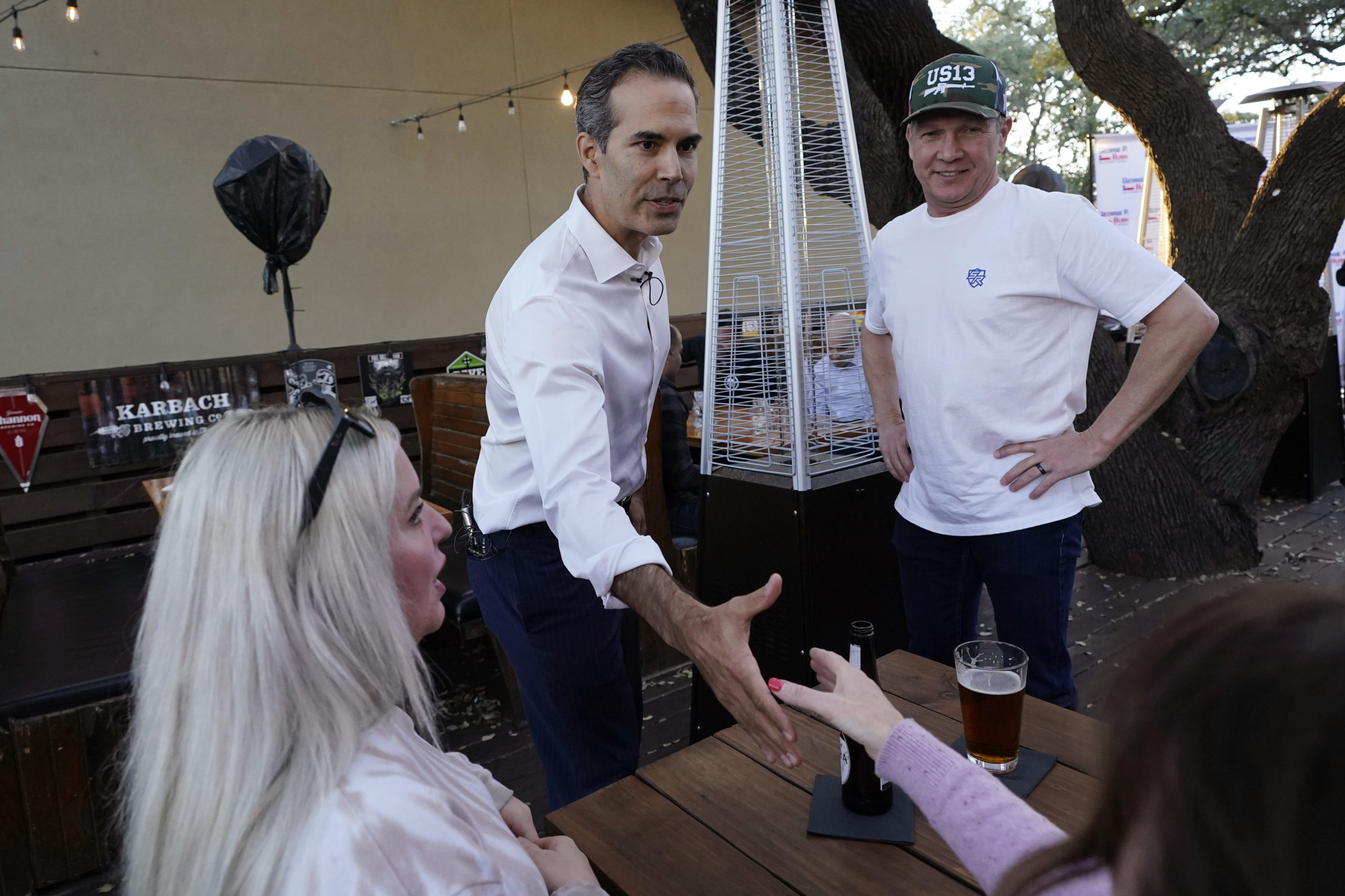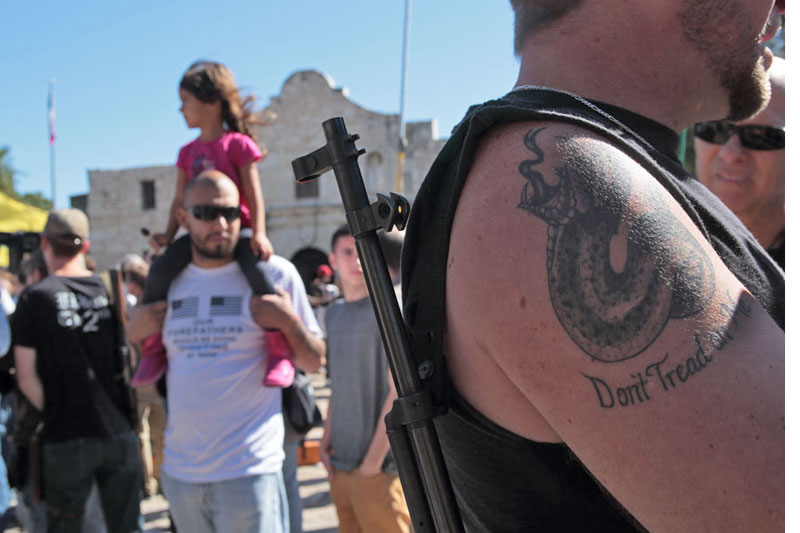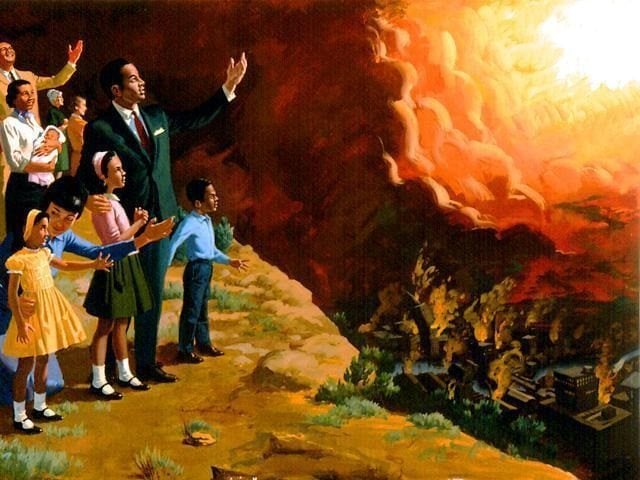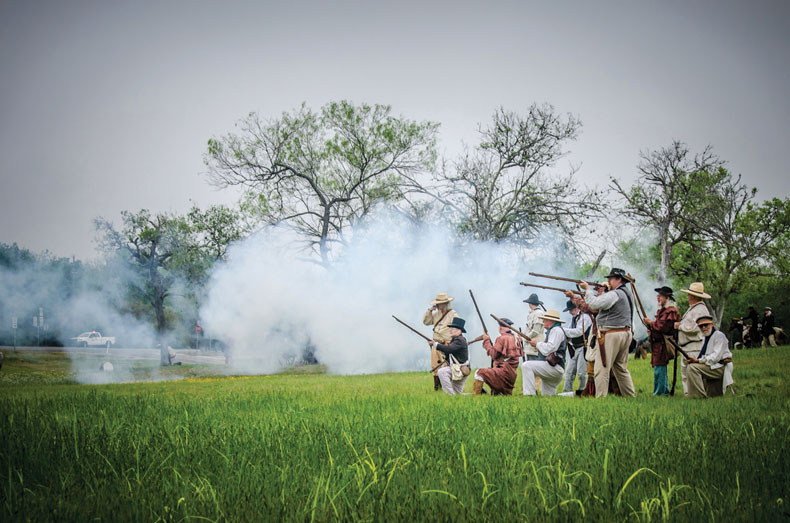
Goliad’s Passion Play: Historic Re-enactors Remember the ‘Goliad Massacre’
A version of this story ran in the May 2013 issue.
Above: Reenactors skirmish outside Presidio La Bahia near Goliad.
For 28 years, Texans have been coming to Goliad, in March, to die. Dressed in authentic period uniforms, historical reenactors do battle outside the stone walls of Presidio La Bahia as hundreds of spectators in lawn chairs watch. The following day, onlookers follow the defeated Texans to a nearby pasture to watch their execution by a Mexican firing squad.
The ritual takes place just outside Goliad, a small town about 100 miles southeast of San Antonio. Tourists visit year-round to explore the state park and nearby presidio, an 18th-century Spanish fort captured by both Mexican and Texian forces—as U.S. immigrants to proto-Texas were called—during the Texas Revolution. Texas history buffs know the dramatic story for which the fort is famous: Midway between the Texians’ March 1836 defeat at the Alamo and their victory the following month at San Jacinto, Col. James Fannin’s troops clashed with Mexican forces in the Battle of Coleto Creek. On March 20, 1836, Fannin’s forces surrendered to Mexican General Jose de Urrea and were imprisoned in the fort’s chapel. A week later, on Palm Sunday, 342 of them were executed on orders from General Antonio Lopez de Santa Anna. Mexican troops marched their able-bodied prisoners to a field and shot them; the wounded, including Fannin, were shot in the fort. About 28 men escaped to tell the tale on which reenactments are based. The battle and execution, popularly (and controversially) referred to as the “Goliad Massacre,” have been recreated each March by costumed members of the Crossroads of Texas Living History Association since 1985.
The cry that galvanized the Texians at San Jacinto was “Remember the Alamo! Remember Goliad!” And memory is what motivates spectators and reenactors to make their annual pilgrimage to Goliad, to retell a story whose ending they already know. They come to commemorate history, to perform as heroes and villains, and to transform defeat into a triumph of Texas independence.
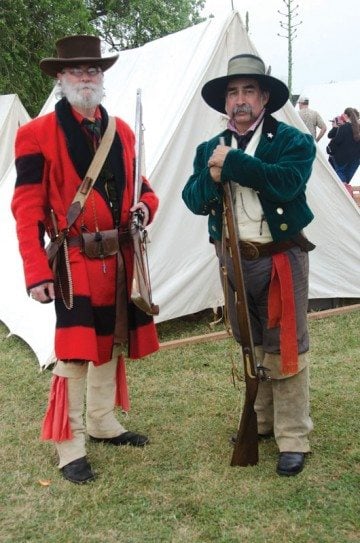
exhibiting campcraft
in character. Alice Burghart
The presidio is about a mile south of Goliad, past the county fairgrounds and across the San Antonio River. It sits atop a hill, about 100 yards from the town’s largest thoroughfare, Highway 183. A stone wall encloses the chapel, priest’s quarters, a small museum and a large open quadrangle where reenactors camp during massacre weekend. Visitors wander among canvas tents and fire pits, asking questions and taking pictures. Outside the presidio walls, the hillside between fort and highway serves as the battleground where Fannin’s troops made their last stand, even though the actual fight took place about nine miles away, near Coleto Creek. The hill makes a convenient amphitheatre where tourists can watch the action while eating sausage wraps from the Boy Scout concession stand.
The massacre program condenses a full week of history into two days. In addition to several military skirmishes, there are “living history” demonstrations at the reenactors’ campsites, lectures and a candlelight tour of the grounds.
The first skirmish begins at 10 a.m. Saturday, with Texian and Mexican soldiers squared off on the hillside. The occasional passing car honks at the spectacle. The breeze carries men’s shouts and smoke from blank musket fire up to the spectators.
The Texians appear to be poor shots. “I don’t understand why our guys are falling and no one’s dead on the other side,” an observer says to his friend. Just then a Mexican soldier falls and the crowd cheers. “They finally got one,” someone says.
Presidio director Newton Warzecha surveys the audience: scout troops, elderly couples, families with young children, Anglo and Hispanic. “Of that crowd out there, at least half have been here more than once,” he tells me. The local newspaper reports attendance of 4,500, most of them from out of town. The reenactors, too, are from all over Texas, drawn here by a shared hobby more than by any personal ties to Goliad. This is the fifth massacre for spectator Alicia Watson of Canyon Lake. She’s brought her grandsons, a sixth-grader and a seventh-grader studying Texas history in school. The reenactment helps the boys understand that the Goliad massacre was a real event, not just something in a book, she says. The takeaway, she suggests, is “to be grateful for our freedom. These men gave their lives. Like in Iraq, or Afghanistan. Because of them, I have the freedom to come here.”
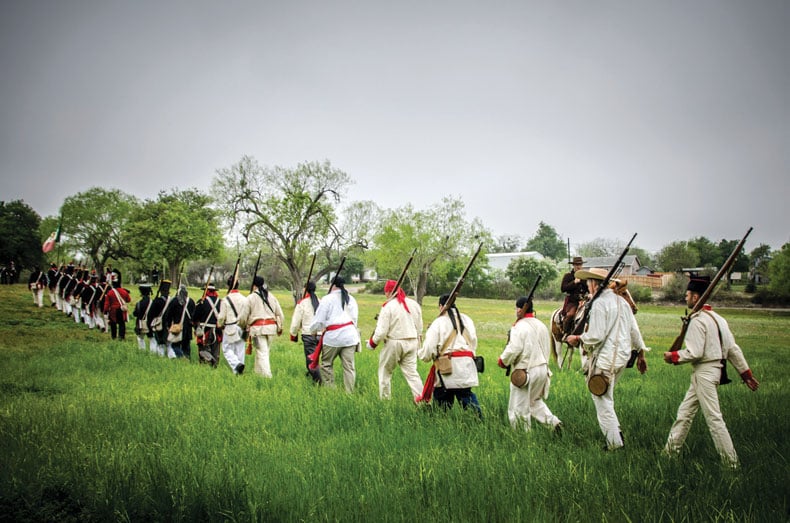
After the skirmish, the crowd drifts into the presidio to walk among the soldiers’ camps and take pictures with reenactors. There are 209 soldiers this year, less than a third of Fannin’s and Urrea’s combined forces. Most reenactors have brought several thousand dollars’ worth of uniforms, weapons and equipment, items they’ve purchased or made themselves over the years. Many will don different gear for other events in coming months: Civil War battles, Depression-era hobo camps, 1830s mountain man competitions. The reenacting community in Texas numbers around 2,000, estimates David Vickers, the reenactor co-coordinator, who affectionately refers to the typical participant as “a peculiar type of lunatic.”
Even more reenactors participate in staged battles at the Alamo, Goliad’s more famous cousin. Reenactors call the period between March 2, the signing of the Texas Declaration of Independence, and March 6, the Battle of the Alamo, the “High Holy Days.”
“[Goliad] is totally overshadowed by the Alamo,” says Vickers, a social studies teacher in Bee County, southeast of Goliad. Reenactors “converge on San Antonio, and there’s 900 Davy Crocketts running around,” he says.
The reenactors who make a point to come to Goliad suggest that it gets slighted by textbook authors and tourists.
“There were twice as many people killed here as at the Alamo, but nobody knows anything about Goliad,” says Clarence Ball of Rancho Viejo, near Brownsville, frowning under his coonskin cap. Reenactors and the better-informed spectators seem to be rooting for the underdog—not just the outnumbered Texian forces, but the historical event itself.
While kids and teenagers pose for pictures by the tents, about 120 people crowd into the presidio chapel to hear Warzecha’s lecture about the fort’s role in the Texas Revolution.
The chapel, called Our Lady of Loreto, is still an active Catholic church that hosts Sunday afternoon mass. This weekend, the building serves both religious and historical purposes: tonight, the Texian soldiers will be marched into the chapel after their defeat. On Sunday, hours after the wounded are lined up against the chapel wall and shot, the 5 p.m. service will retell the story of Jesus’ betrayal and crucifixion.
Standing in front of the altar, Warzecha explains that after the fall of the Alamo, Sam Houston ordered Fannin to retreat from the presidio to Victoria, about 30 miles east. Fannin received the order on March 13 or 14 but delayed his retreat, partly because hubris and prejudice made him underestimate the Mexican forces. When he finally began the retreat on March 19, progress was slow and disorganized, and his forces were overtaken by Urrea. The morning after the Battle of Coleto Creek, his supplies exhausted, Fannin surrendered, giving his men the impression they would be treated humanely as prisoners of war.
The Texans were marched or carried the nine miles back to the presidio, where they were held in Our Lady of Loreto for six days. On the seventh day, those who could walk were marched out and shot.
“Now, there’s confusion about the Texas Revolution,” Warzecha tells the group. “Many people thought for years it was an Anglo-Mexican war. It was not an Anglo-Mexican war. It was a civil war within the country of Mexico.
“It’s very important that we pay attention to history,” he concludes, “because if we don’t, we keep reliving it over and over again.”
It’s hard to imagine what aspects of the Goliad massacre modern Texans are in danger of repeating, but to Warzecha the most relevant character is Santa Anna. “We had a dictator [Santa Anna] who ran roughshod over his country, over his people south of the Rio Grande just like north of the Rio Grande,” he says. “It’s happened time and time again since then—Castro, Chavez, Hussein. People need to understand what happens when you let someone like that gain total control, and … work not to let that happen.”
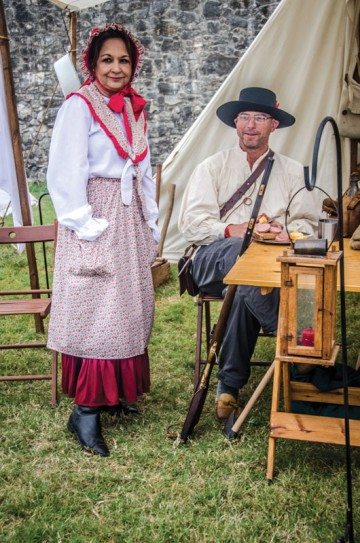
exhibiting campcraft
in character. Alice Burghart
A tall, thin man with intense dark eyes, Warzecha stumbled into his position as director 22 years ago. The presidio, which is owned by the Catholic Diocese of Victoria, was in physical and financial disrepair, and the diocese was spending about $50,000 a year to keep it running. When Warzecha, a business consultant and a Catholic, sought to volunteer, the bishop asked him to review the presidio’s problems. After Warzecha submitted recommendations, he was asked to serve as director until someone else could be hired. “That’s been 22 years, and they haven’t found anybody yet,” Warzecha chuckles.
When he arrived the fort’s walls were cracked and covered with vines. Now the facility is in “tip-top shape, excellent condition,” he says. The cracks have been patched, the chapel interior painted, and the sidewalks made ADA-compliant.
The fort receives no tax dollars or church money. Under Warzecha, it’s become self-supporting with funds raised by a foundation and a Friends of the Fort group. The presidio rents its chapel for weddings and the old priest’s quarters for overnight guests. Admission and gift shop sales over massacre weekend (“Remember Goliad!” Frisbees cost $2) total about $11,000—roughly 10 percent of the fort’s annual operating income. A dinner and auction on Saturday night raises another $30,000.
Warzecha, who would seem stern if he weren’t so hospitable to visitors, retains the businesslike demeanor that helped him turn the presidio around. Several times during the weekend he reminds me that the best magazine stories about the presidio present “just the facts.”
History is always more than “just the facts,” and the interpretations on display at Goliad’s reenactment are sometimes criticized for perpetuating anti-Hispanic prejudice.
“Lots of young children come to see this, and lots of people that really don’t know the history,” explains Estella Zermeno, whose family has lived in Goliad since 1749. “They come to the reenactment to see all the shooting and killing, and they get the wrong impression. They say the Mexicans are bad people.”
That was the narrative Zermeno learned in history class in her segregated Goliad grade school. “I was so embarrassed, I wanted to crawl under my desk and hide because my people, the Mexicans, were so bad,” she remembers. Zermeno and her husband have tried to change that perception by advocating for historical markers commemorating the Tejano people and serving on the committee that brought the Tejano monument to the state Capitol in 2012.
A dozen or so years ago Zermeno asked Warzecha to stop using the word “massacre” in descriptions of the weekend’s events, and use “execution” instead. “Massacre” connotes that the dead were unarmed, or that there were a lot of them. But under the Tornel Decree, issued by the Mexican congress in December 1835, any armed foreigners in the country were to be treated as pirates and executed. Most of the Texian forces at Goliad were adventurers from the United States; Fannin hailed from Georgia, and a large regiment had come from Alabama.
“Generally speaking, a massacre happens to civilians, and an execution happens to military people,” says Dennis Riedesel, a Goliad reenactor and scholar who has taught middle school and college courses. “So, sorta-kinda-roughly this was an execution.”
From the Mexican point of view, the Texian forces were land pirates who had crossed the border to fight.
Zermeno is concerned not so much with defending the Mexican army, but with how the term “massacre” plays to modern audiences. She thinks it reinforces revolution-era anti-Mexican sentiments that have transferred to contemporary Tejanos.
Reenactors, whose ranks include both Anglo and Hispanic men, resist this criticism, as does Warzecha, who notes that he’s asked scholars the most appropriate term to use, and says most support “massacre.”
But Zermeno’s concerns are shared by Leigh Clemons, an independent scholar and cultural historian who has written about the Goliad reenactment in two books.
“If this is the only way you learn about history—if it is history as entertainment—what is the message being portrayed?” she asks. “Granted, we’ve gotten away from the John Wayne approach to the battle and the representation of Texas history, but that doesn’t mean we’ve reached a point where the gray areas on all sides of the conflict are acknowledged. If you do that, then the narrative becomes so complicated you can’t sell it to an audience. It’s not fun anymore.”
Warzecha and Zermeno today maintain a polite semantic disagreement, and Zermeno says her opinion of the reenactment has improved over the years, partly due to reenactors’ efforts to convey the event’s complexity.
“We’ve tried to portray both sides as much as we can,” says Vickers, the reenactors’ leader. “We put a lot of this off on the fact that a dictator made this order. There wasn’t much that General Urrea and his men could do.”
It’s not hard to think of the reenactment as a passion play—a story of betrayal, execution and triumph repeated each year amid lingering questions about whether the story incites prejudice against the executioners—especially since it takes place on Palm Sunday. In this context, Urrea represents Pontius Pilate. He wasn’t at the presidio when the execution orders came from Santa Anna—they were carried out by another officer—and Urrea’s own writings suggest he was grieved and embarrassed by the executions. “He was actually a pretty noble human being,” Vickers says. “He didn’t want to do this. Many of his officers didn’t want to do this. It’s such a complex story.”
Such nuances are most evident during the Saturday night candlelight tour. A guide leads small groups around the fort to watch reenactors perform four vignettes that might have occurred the night before the execution.
The first scenario involves a tense exchange between a Texian soldier and a Mexican officer who had been friends before the war. In the morning the Texian soldier will be pulled from the death march, though it’s hard to tell what’s happening. Some Mexican officers rescued friends, and a Mexican woman named Francita Alavez [one of several variant spellings], a consort of an officer, intervened on behalf of several Texians. Alavez is now known as the “Angel of Goliad” and is commemorated with a statue near the fort, where her descendents lay a wreath each year after the reenactment.
Another scene depicts Mexican officers receiving Santa Anna’s order to execute the prisoners. Surprised and disturbed, they argue about what to do, weighing their reluctance against fear of the consequences if they fail to follow orders. They are Catholics, one officer reminds the others. Tomorrow is Palm Sunday. They don’t want to execute anyone on a holy day.
Both Zermeno and Clemons point out that the scene is conducted in Spanish, and while “it’s authentic because they are arguing in Spanish,” Clemons says, “it’s also limiting, because if you don’t speak Spanish you just see a lot of people yelling at one another in a foreign language, and you don’t know what they’re yelling about.”
On Palm Sunday 1836, the able-bodied prisoners were herded from the chapel. The men were divided into three groups, marched in different directions (singing, some accounts say, thinking they were being sent home), and then, less than a mile from the fort, shot. Twenty-eight men survived; some, like doctors, were deemed useful to the Mexican army and pulled from the march. Others ran when the gunfire began and disappeared into the brush by the nearby San Antonio River.
Palm Sunday 2013 dawns windy and cold, the sun muted behind a white sky. A shivering crowd follows the column of soldiers to a pasture on private property, where the Mexican cavalry leaves us standing at a barbed-wire fence. The Texians continue into the field, stopping to rest about 30 yards from the Mexican army.
The Mexican soldiers raise their rifles. “What are they doing?” yells a Texian, and the men bolt as gunfire fills the field. Most of the Texians fall. A few scramble toward the river and are followed by Mexican officers on horseback. We hear more shots in the trees while the soldiers inspect the bodies in the field, bayoneting the men who aren’t quite dead.
After a moment, the crowd pulls away from the fence and starts back toward the fort. “Aw, man,” a 5-year-old boy says, “all the Texans died.” We walk through sweet-smelling fields of bluebonnets and mustard-yellow daisies, beneath a sun that’s grown warm and friendly. I turn and look back at the dead Texians. A man is taking a photo of his two young, smiling daughters with the motionless bodies as a backdrop.
“I like Sunday,” says Michael Martinez, one of the few locals I meet, who dresses as a Tejano on the Texian side for the execution. “When you actually get to participate in the death march, that puts a lump in your throat. It gives you a great sense of, ‘I’m a part of all this, I’m keeping their memory and their story alive.’”
Back at the presidio, the wounded are lined up and shot. A reenactor playing Fannin is blindfolded and shot at close range. A Mexican officer turns to the crowd, explaining the Tornel Decree and justifying the executions.
“If at this time in 2013 you find that disagreeable, you have to understand that many nations will go to any means to protect their security,” he announces. “Thank you for supporting this historical site. By being here you commemorate these men’s lives through the ages.”
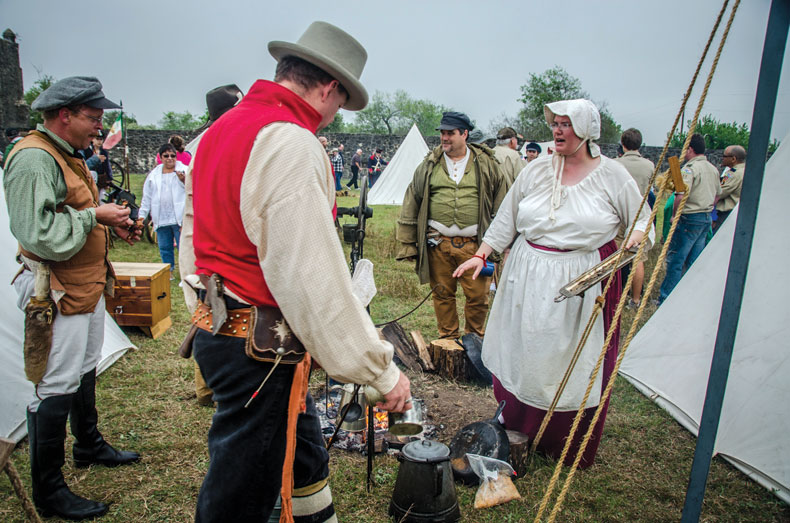
It’s hard to make sense of so much carnage, particularly since it was avoidable. Fannin’s indecision and overconfidence likely cost his men their lives. A letter Fannin wrote a month before his surrender to Urrea suggests the colonel had even begun to doubt his own leadership.
Some say there was victory buried in the Goliad defeat—that without the anger and outrage over the Texians’ deaths, the remaining forces wouldn’t have found the motivation, or enlisted the additional troops, to win at San Jacinto three weeks later.
Zermeno, Vickers and Clemons emphasize that history is written by the victors. “Even though this battle was not won by the Texian army, the Texans ultimately won,” Clemons says. “So they were able to position Goliad in the overall narrative of the Texas Revolution.
“History is always written by people with a point of view. History is not the event, history is the interpretation of the event, and people are always going to interpret the events differently.”
For local reenactor Michael Martinez, the point of telling Goliad’s story is to reinforce a shared Texas heritage. His words contain the sense of manifest destiny echoed by many spectators, in whose minds Goliad was an unavoidable sacrifice on the way to Texas’ ultimate triumph.
“If it wasn’t for the incidents here, at the Alamo, and San Jacinto, this would still be Mexico,” he says. “There would have never been an Astrodome, there would have never been the HemisFair Tower of the Americas, people wouldn’t have their ranches, their businesses and all that. It’s the events of the revolution that gave us Texas.”
A gate in the presidio’s wall has opened, and cars slowly enter and pull up to the campsites. Men load their canvas tents, their pots and cooking gear, their period rifles, into sedans and pickups. Now wearing jeans, western shirts and cowboy hats, they shake hands and hug before getting into their vehicles.
The presidio, hours earlier a killing field, now has the aura of the last day of summer camp. Some of these men will see each other next month at San Jacinto. Some will meet again this summer on Civil War battlefields. And others won’t see each other until next year in Goliad, eager to give their lives for the cause of history one more time.
